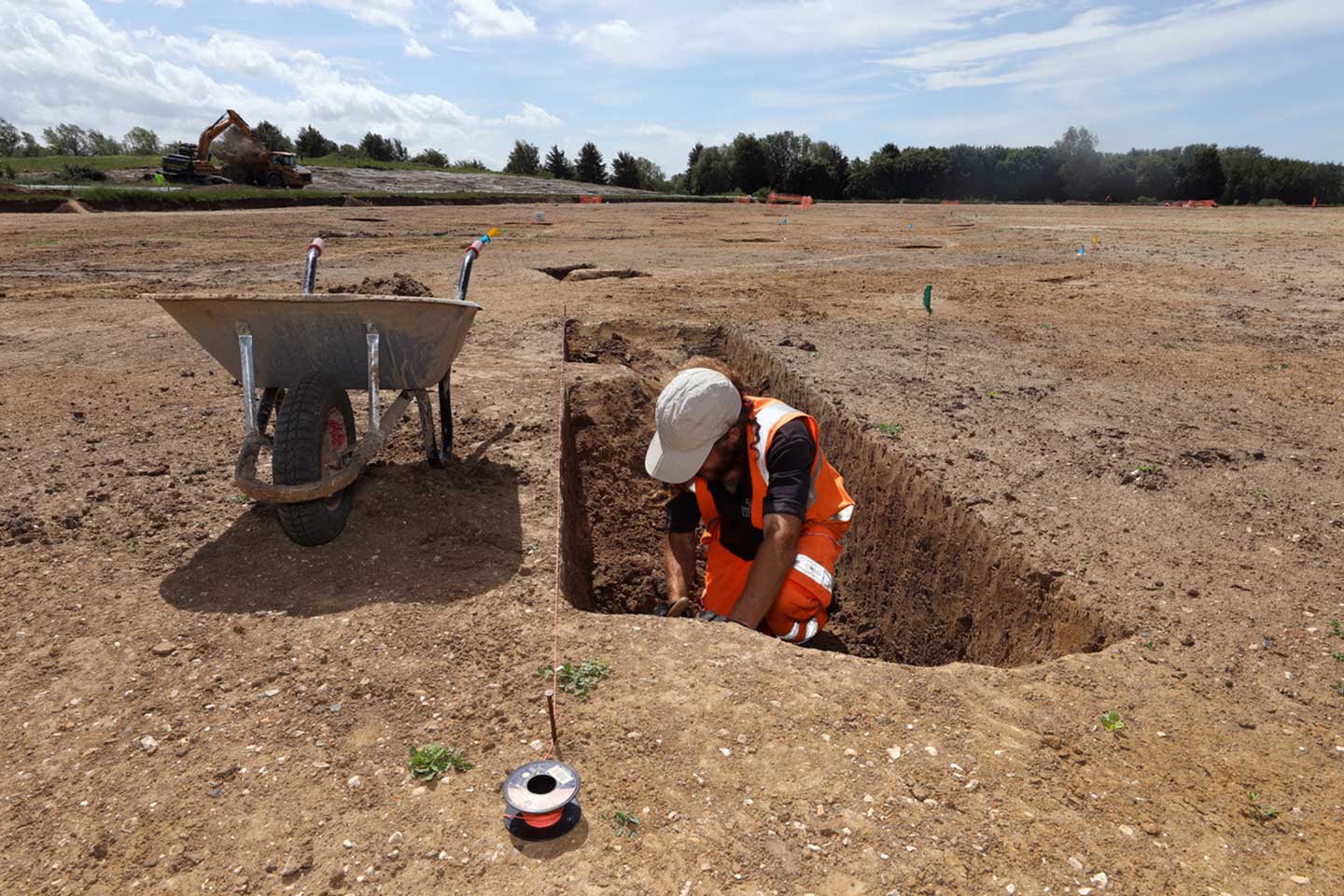Before work starts on the first phase of development at Waterbeach Barracks, extensive archaeological investigations have been carried out to capture the history of previous residents and allow their story to inform the future designs and features of the new development. This includes three areas of Roman settlement, two areas of Roman industry and numerous areas of medieval field system (known as ridge and furrow).
The Waterbeach development is located at the junction of two important Roman regional transport links: the Car Dyke (Old Tillage) Roman canal which is one of the greatest engineering feats carried out by Romans in Britain – and the Roman road known as Akeman Street, which connects Ermine Street near Wimpole Hall and runs along the alignment of Mere Way joining the broad route of the A10 up to the North Norfolk coast. These connections made the area an appealing location for living and trading, and Oxford Archaeology East is working with the developers Urban&Civic to piece together the jigsaw of Waterbeach Barracks’ past.
Based in Bar Hill, Cambridge, Oxford Archaeology East has been working with Urban&Civic and Cambridgeshire County Council’s Historic Environment Team to investigate the site since 2016 following a long history of research and analysis in the wider area. Their input to the design and planning team has been a key part in ensuring the new development respects, works with and captures the many layers of history of this site.
Following desk-based research and geophysical surveys of the key areas of the site, the archaeology team opened nearly 140 archaeological trial trenches across the entire site to further explore what buried archaeological remains could survived the more recent agricultural and military uses and development of the airfield.
Over the last few weeks Oxford Archaeology East has now dug approximately 7ha – the size of 10 football pitches – in the northern corner of the airfield, where early evaluation identified a potential Roman settlement.
Having stripped the topsoil with excavators, the team was able to delve deeper with hand tools to explore and interpret the layers of history beneath. This included a complex system of ditches, dating to the latest Iron Age and Early Roman period (c. 2000 years old) as well as lot of artefacts: from Roman pottery and coins to an amazing Bronze Age palstave axe-head. A number of pottery kilns were also found that would have produced pottery during the Roman period – likely of similar style to the well-known Horningsea wares produced in Cambridgeshire along the fen-edge in the 2nd to 4th centuries.
Stephen Macaulay, from Oxford Archaeology East, said: “Waterbeach Barracks is a fascinating site and the new development gives us a unique opportunity to capture the essence of its foundations and an understanding of how our ancestors lived and worked the land. It is great working with Urban&Civic, who will reflect this in the new development, which really helps engage people with the past: which is really important to us.
“The site is in a unique location and the historic role of Car Dyke and Akeman Street Roman road (the modern A10) and water connections need more celebration within Cambridgeshire. Hopefully the approach at Waterbeach is the start of making that happen.”
Unfortunately, Covid 19 has meant that the plan to involve local schools and community input to the digging, cleaning and sorting of finds could not happen, and so the team is now pulling together the finds, analysis and reports to be able to share the information more widely. A full report and analysis will be worked up to detail the finds and put them in their historic context. This will then form part of exhibitions and events for local communities and schools, as the restrictions ease. Further archaeological excavations will take place in advance of each phase of development at Waterbeach Barracks and so the work will be an ongoing process, revealing more about the story of the site each time and providing further information on the Iron Age and Roman settlements of Waterbeach and the wider Cambridgeshire fen-edge.
Rebecca Britton, Communities and Partnerships for Urban&Civic said: “Waterbeach Barracks is a historic place with rich layers of heritage that span millennia. While the recent military past is something that we are all familiar with, this work enables us to dig deeper into the past, find out more about how our predecessors lived and what they did here. This is not only incredibly useful in informing our understanding of the past, but also provides a rich seam of inspiration for the future development: whether its street or park names, the design of public art, or part of connecting future residents with the history literally under their feet.
“History is a great way of establishing connection between people and is part of our wider commitment to working with Denny Abbey, the Tithe Barn at Landbeach, Wicken Fen and other important local heritage assets to engage people with and celebrate the amazing history around us in this part of Cambridgeshire.”
Once Coronavirus restrictions are lifted, Urban&Civic will be working with Oxford Archaeology East to provide opportunities for current and future Waterbeach residents to discover more about their Roman predecessors as well as more recent military usage of the site, through school visits, site open days and community projects.
